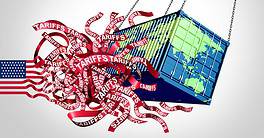Bank partnerships proliferate as the quest to deliver real-time payments intensifies. But with added speed comes added risk.
Why settle for slow? When it comes to processing payments, it’s better for a bank to be “always on,” says Debopama Sen, Citi Services’ head of Payments in the Treasury and Trade Solutions business.
Big banks, like Citi, are jockeying to be their clients’ single “port of call” when it comes to transacting. To get there, they’re leveraging their respective strengths and forging partnerships to create new and innovative payment solutions that can move money across borders at any minute of the day with unprecedented speed.
As Sen puts it: “You cannot wait for the US to open.”
For years, clients were clamoring for a fast-lane-like option to transfer money without hitting the dreaded roadblocks that come with different time zones, early cutoffs, and regulatory delays.
This year, their wish was granted. Citi and Emirates NBD recently launched a 24/7 US dollar clearing service. Some 200 clients now use it to send and receive payments.
“This was a great partnership with another bank,” Sen says, hailing the project as “a milestone event.”
At least two other firms—BNP Paribas and BNY Mellon—also recently celebrated the launch of new payment initiatives with speedier service. At a glance, 2024 is shaping up as the year “round-the-clock” became a reality for merchant, consumer, and business-to-business transactions.
“Perhaps it wasn’t important eight years ago, but it’s very important today,” says Sen.
Shortly after Citi confirmed its partnership with Emirates NBD, BNP Paribas touted its own “new era” when the Paris-based bank executed its first “express payment” to Australia. The transaction, completed on July 2, was in partnership with Melbourne-based ANZ Group Holdings.
“With this partnership, we are using the new capability of the local Aussie instant rails to settle real-time [payments], but with full transparency,” says Wim Grosemans, BNP Paribas’ head of Product Management, Payments and Receivables, Cash Management. “It’s the right and future-proof way of doing things.”
BNY Mellon is also working to speed up. In August, the New York-based bank teamed up with Commonwealth Bank of Australia (CBA) to enable completion of international payments in as little as 60 seconds.
For CBA, one of Australia’s largest financial institutions, the move expands its presence in the global payments space. BNY boasts that commercial payments from overseas to businesses and individuals with Australian bank accounts “will now be available to the final beneficiary in under a minute, 24 hours a day, seven days a week.”
That shift underscores what appears to be a new benchmark, says Samit Soni, a partner in Bain & Company’s financial services practice: “There is a desire for banks to enable payments in less than a minute.”
‘Exciting Times’
The need-for-speed attitude in the payments sector coincides with a larger trend: Corporates now find themselves in a world where the new normal flow of business is 24/7. US Treasuries and stock index futures, for example, can be traded at any time from Monday to Friday; retail traders are increasingly using platforms like Robinhood for 24-hour weekday access to US stocks; and the New York Stock Exchange—for the first time ever—is expressing interest in a 24/7 bourse.
A seamless experience is also in demand, as evidenced by a massive transition in cross-border payments, converging from a wide variety of legacy message and data formats to ISO 20022, a common, global, end-to-end standard. Grosemans sums it up as “exciting times.”
Regulators like what they hear, too. Cross-border mandates are now cropping up with the aim of accelerating real-time payment adoption between regions.

Bain’s Soni recalls the linkage agreement between Singapore’s PayNow system and India’s Unified Payments Interface from earlier this year. The initiative allows customers from participating banks in both nations to transfer funds instantly using just a mobile number or virtual payment address.
Merger and acquisition activity is also returning as legacy firms remain on the hunt for companies with a payment specialty. US Bank, for instance, purchased Tempe, Arizona-based Salucro, a 20-year-old shop known for innovating in the health care payments space, in August.
“Dealmaking seems to have picked up,” Soni says, noting that Bain is in the process of assembling its next M&A report on payments. Preliminary data show deal value in the payments space for 2024 at around $53 billion: higher than in 2023, when it barely hit $30 billion. Around this time last year, overall deal value for fintechs dropped 23% while volume fell 30% over the first nine months of 2023.
This year, it’s a different scenario.
There are several reasons why deal activity is more vibrant, Soni says. One reason is that corporates like to cherry-pick assets that enhance their capabilities. Additionally, many incumbent firms are restructuring by spinning off their payments divisions into standalone entities to capture higher valuations.
Lastly, while fintech startups may have attractive offerings, they find themselves cash-strapped on the heels of a weak fundraising environment. Nowadays, they’re more willing to hear what buyers have to offer.
“M&A is picking up, from what we are seeing on the ground,” says Logan Allin, founder of global asset manager Fin Capital. Allin’s firm, which boasts 120-plus investments in fintech software, recently announced two fintech-related exits: NeuroID, to Dublin-based Experian PLC; and Salt Labs, to San Francisco-based Chime Financial.
The fact that interest rates are coming down helps when it comes to dealmaking, he adds: “We believe that the specter of interest rate cuts is driving M&A corp-dev departments to move more quickly with a view that companies [and] asset values will be more expensive in the future.”
Among the early-stage companies that were acquired this year, there’s consumer credit startup Petal, which sold to Mexico’s Empower Finance in April. In June, São Paulo-based Nubank scooped up Hyperplane, an AI-powered startup that builds personalized product offerings.
Young, Hungry… Risky?
A startup that takes one specific customer problem and solves it “extremely well” is attractive, Citi’s Sen says. Citi has often found itself on the buyside in recent years.
In 2019, it purchased PayQuik, a fintech company specializing in real-time, cross-border payments. In 2020, it acquired Vadiyya, a fintech startup focused on enhancing payment processing technology, particularly for small and medium-size enterprises. And in 2022, Citi explored the burgeoning blockchain space and bought a stake in BondEvalue, a bond trading platform.
Citi is still on the lookout for the newest tech.
“The really new, young, hungry disruptors are definitely a space to watch out for,” Sen says. “Banking clients are looking for a one-stop shop, or a one-stop solution across a wide section of markets to serve the end-to-end need. And so sometimes we partner with some of these players to bring that together as well.”
But as the market moves faster and tech gets more innovative, so do the attendant threats. As digital commerce becomes more democratized, regulators are growing increasingly worried about financial crime, Sen notes.
“Today, they’re dealing with many small counterparties, and they may or may not necessarily have the wherewithal to manage that risk,” she says. “Therefore, having those monitoring systems in place, having proactive risk management for managing financial crime, I think, is something that the industry is very aware of, and so is the regulator.”
Indeed, financial crime is on an upward trend. Last year, the Federal Trade Commission reported that the US alone recorded over $10 billion in fraud losses, a 14% increase compared to 2022. Investment scams were particularly damaging, accounting for nearly half of these losses.
At the global level, financial crimes such as money laundering, terrorist financing, and human trafficking contributed to trillions of dollars in illicit funds flowing through the financial system in 2023, with fraud alone causing projected losses of nearly $486 billion.
Driving this explosion of malfeasance are factors including advancements in digital tools that criminals employ. With transactions happening in the blink of an eye, preventative steps have difficulty catching up, BNP Paribas’ Grosemans says.
“There are all types of fraud strategies and new fraud strategies are being invented every day,” he adds. “There is a systemic risk there and we have to get our heads around what that means and how we protect customers against fraud.”




